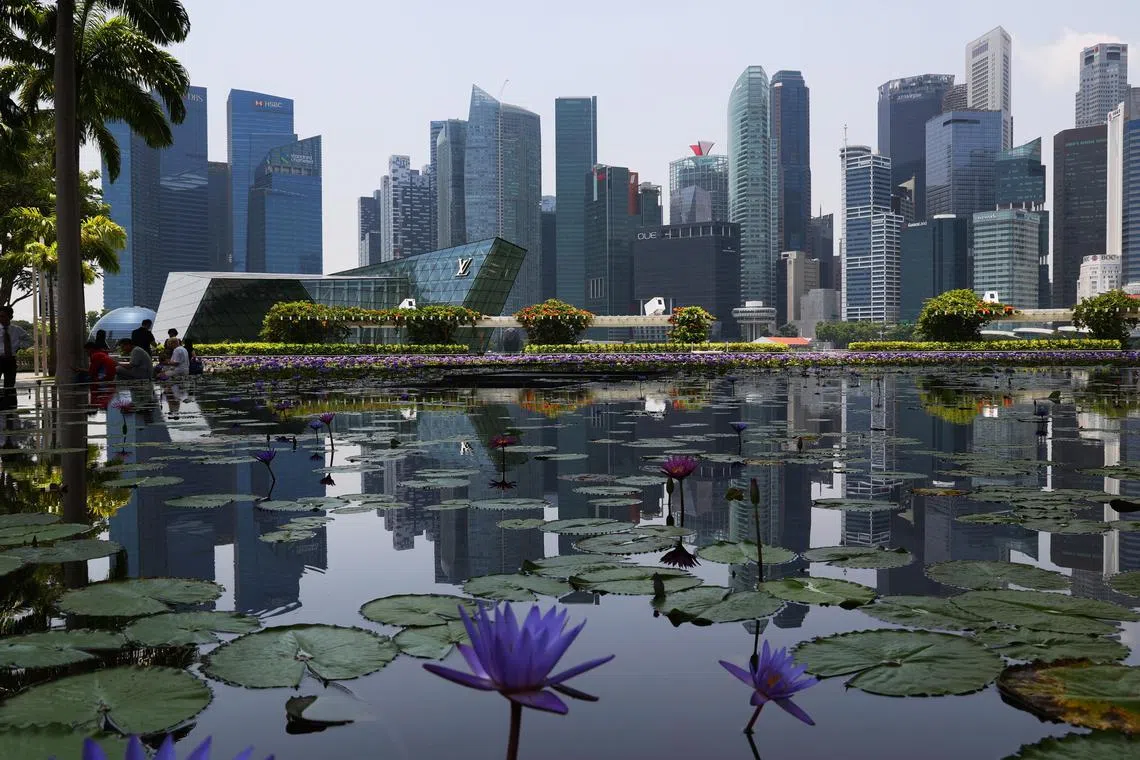S’pore economy saw better-than-expected growth of 2.9% in Q2; Q1 growth revised up to 3%
Sign up now: Get ST's newsletters delivered to your inbox

On a quarter-on-quarter basis and seasonally adjusted, the economy expanded 0.4 per cent, the most since the second quarter of 2023.
PHOTO: LIANHE ZAOBAO
Follow topic:
SINGAPORE - Economic growth in the past three months added to the fastest pace of expansion in six quarters, as reviving global demand for electronic goods put Singapore’s semiconductor industry back in the driving seat.
Gross domestic product (GDP) grew 2.9 per cent year on year in the second quarter, according to advance estimates from the Ministry of Trade and Industry (MTI) on July 12. That came after the first-quarter growth was revised higher to 3 per cent – the fastest pace since the 4.2 per cent expansion in the third quarter of 2022.
On a quarter-on-quarter basis and seasonally adjusted, the economy expanded 0.4 per cent, the most since the second quarter of 2023 and up from a revised 0.3 per cent gain in the first quarter of 2024.
The year-on-year growth was higher than the 2.7 per cent forecast by economists polled by Bloomberg, while quarter-on-quarter growth was in line with their projection.
Growth was supported by a 0.5 per cent year-on-year rebound in manufacturing, after a 1.7 per cent contraction in the first three months of the year.
Along with construction that grew 4.3 per cent, the overall goods-producing industry posted an expansion of 1.3 per cent versus contraction of 0.7 per cent.
The manufacturing sector expansion in the second quarter saw growth across all its clusters, except for biomedical manufacturing and precision engineering, said MTI.
On a quarter-on-quarter seasonally adjusted basis, manufacturing grew by 0.6 per cent, rebounding from the 5.3 per cent contraction in the first quarter.
Second-quarter GDP growth was also aided by the group of clusters comprising the information and communications, finance and insurance, and professional services sectors. Together, they grew by 5.6 per cent year on year, extending the 5.7 per cent growth in the first quarter.
However, growth slowed in the services sector to 1.9 per cent from 3 per cent in the previous quarter. This sector comprises accommodation and food services, real estate, administrative and support services, and other services.
Still, the overall spurt in GDP growth will likely help the economy achieve MTI’s full-year 2024 forecast of 1 per cent to 3 per cent growth.
With first-half growth coming at 3 per cent – at the top end of the MTI forecast – most analysts quickly upgraded their own estimates.
Oxford Economics raised its 2024 GDP forecast to 2.5 per cent from 2.2 per cent. Ms Sheana Yue, an economist at the Britain-based independent advisory firm, said the manufacturing rebound means goods exports should continue to provide a much-needed boost to the economy thanks to the upturn in the global chips cycle.
However, Singapore’s domestic demand is likely to stay sluggish.
“Softer labour demand and high interest rates are likely to deter investment and keep Singaporean consumers in cautious mode,” said Ms Yue.
OCBC Bank also raised its 2024 GDP forecast to 2.6 per cent from 2.3 per cent.
Ms Selena Ling, its head of research and strategy, said the external economic environment has improved as more investors now believe in the global soft landing narrative – the end of the inflationary surge without a recession. Also, expectations are rising that the US Federal Reserve will deliver a rate cut soon.
But the global geopolitical landscape remains fraught with uncertainties.
The key event risk on the horizon is the November presidential election in the United States, with a high probability of Donald Trump winning another term.
Trump has pledged to slap a flat 60 per cent tariff on all imports from China and 10 per cent on shipments from the rest of the world.
Ms Ling said if traders decide to front load exports and imports in anticipation of a tougher trade environment in 2025, manufacturing and exports growth may in fact accelerate across Asia.
“This may ironically be a tailwind for manufacturing and trade,” she said.
The GDP data follows June’s release of factory output figures, showing a surprise 2.9 per cent year-on-year rebound in May.
In that report, the jump in manufacturing was powered by the electronics sector’s robust growth of 20.1 per cent against a 1.1 contraction in April. The strongest performance within electronics was from the semiconductor segment which rebounded by 20.6 per cent in May after shrinking 2.6 per cent in April and 14.3 per cent in March.
The strength of global demand was also reflected in the recent surge in container and air cargo traffic at Singapore ports.
Changi Airport reported 170,000 tonnes in air freight handled in May, a 20 per cent year-on-year jump.
Despite congestion at ports worldwide due to the Red Sea crisis, container throughput at Singapore’s port hit the highest level in 2024 in May at 3.5 million twenty-foot equivalent units.
Still, purchasing managers’ index data from Singapore and across Asia showed supplier delivery times have likely risen as vessels were diverted to Africa’s Cape of Good Hope, to avoid the ongoing attacks by Houthi rebels on Red Sea ships.
Some analysts have warned that the rerouting – which has already led to an increase in sailing times and upward pressure on freight rates – could have a chilling effect on exports going forward.


